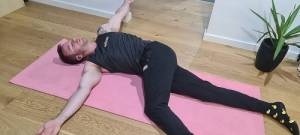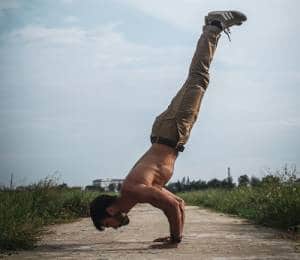Running is one of the most popular physical activities in the human race. This preference is probably dictated by our innate instinct that throughout evolution pushed us towards scraping for food, getting away from predators, long-distance migrations, etc. Having that in mind we can assume, that we were “made” for running.
If you are already in the “running club”, we are really happy to have you! You are probably wondering if there is an effective way of enhancing your performance. The answer is simple – yes, and it’s called strength training. In fact, there are several ways to improve your running performance. What you eat and how you supplement your diet and how much rest you’re getting, are also highly important factors that accelerate your running performance.
First, we need to understand how a human body works. Our “biological machine” is equipped with slow-twitch and fast-twitch fibres. The first group is responsible for endurance activities, while the second one is used to perform explosive movements that require strength. In order to increase our performance, we should strive to increase the number of less dominant fibres and enhance the capacity of already existing.
Secondly, we use not only our legs but also other muscles. Did you know that we use 70% of all body muscles while running? Core and leg muscles are ones to develop in order to become a better runner. To make sure that everything works for long and beyond reproach, we need to delve into specific exercises.
The main criteria that we need to take into consideration is complex bodyweight exercises. One of the disciplines that offer a wide variety of such exercises is calisthenics. We don’t need any specific equipment, as all exercises can be performed solely with our bodyweight. If we have an opportunity to use some gear, we can incorporate resistance bands, pull-up bars, or heavy balls too.
If we are beginners to strength training, we need to start with slow progression. That means a lot of patience put into proper form and slow, accurate movements. It’s important to do the exercises the best to our abilities, as perfect form translates into perfect form while running. In the beginning, we can start with 1 set of 4-5 exercises, 12-15 repetitions each. As we progress, we can increase the number of sets to 2, and eventually to 3, with the same number of repetitions. We can also change our standard routine by adding harder variations of exercises (e.g. one-leg variations). Below I present you the best calisthenics exercises for runners:
Squats
Basic exercise that we will incorporate into our calisthenics routine. There are a few useful tips concerning the technique that you need to remember. First, feet must be placed hip distance apart, facing forward. Second, as you bend your knees, they need to outreach your toes. Third, you need to descend to a 90-degree angle in your knees. As you become familiar with the basic movement, you can try:
Sumo Squats
Feet placed twice the hip distance apart, facing outwards. The rest of the instructions are the same as for the standard squats.
Single Leg Skater Squats
One foot facing towards, the second one lifted up from the floor. Bend over till your leg reaches 90-degree angle, push your lifted leg to the rear and reach the ground with your hand. Come back to the initial position and repeat with the other leg.
Single Leg Pistol Squats
One foot facing towards, the second one lifted up from the floor. Bend your first leg and descend to the ground, so your bottom almost touches the heel. At the same time, the second leg should be straight and extended forward, along with your arms to maintain the balance. Remember to keep your body as straight as possible. Come back to the initial position and switch legs.
Single Leg Dragon Squats
Feet hip apart, facing forwards. Cross the right leg behind you, bend your left knee and extend the right leg. It should be under your left leg, parallel to the ground. Lift up and repeat with the other leg.
Lunges
Another great exercise to work on your strength, especially glutes. It’s also known under the name “split squat”. Stand in a neutral position, feet placed hip apart, facing forwards. Do a big step forward and bend your knees, so that the lead leg knee is at 90-degree angle. Step back and repeat with the other leg. Do 12-15 repetitions.
Forward Lunge
In this variation, you simply move forward, instead of stepping backwards. I’d recommend this variation if you have a lot of free space and would like to improve your balance.
Side Lunge
Starting from the neutral position, put your foot aside and bend your lead leg knee at 90-degree angle. The other leg should remain straight. Keep in mind that this exercise requires greater flexibility.
Jumping Lunge
This variation is a combination of standard lunge and forward lunge. Here you just jump into the air to switch legs. This explosive movement might be tiring, so you should start it with a lower range of repetitions, preferably 8-10.
Bridges
This exercise is often neglected by many sports enthusiast. Its aim is to strengthen our core muscles (lower back, abs, diaphragm), as well as glutes and hips. To perform this exercise, lie down on the floor with your arms resting along your body. Plant your feet on the ground and bend your knees, so your legs and core are aligned. Hold this position for at least 2 seconds and lower back to the floor. Repeat 12-15 times. As you progress you can try other variations of this exercise:
One Leg Bridges
Same as standard bridges, but with one leg extended up in the air.
Straight Bridges
Legs placed as in the standard bridge. The only change is that you engage your arms (mainly shoulders). Your hands should be placed outside of your hips, facing forwards. Lift up your whole body, so that it rests only on your feet and hands. Maintain a straight position for 2 seconds before you lower yourself down. Repeat 12-15 times.
Elevated Bridges
Everything is the same as in the straight bridge, but the only change is in your feet placement. This time you will need to find some elevation (knee-high preferably) where you will put your legs, fully extended. Remember to keep your arms straight and squeeze your bottom when you lift up your body. Maintain the straight position for 2 seconds and lower your body. Repeat 12-15 times.
Full Bridges
This exercise is the most advanced one and should be performed only if you are stretched out properly. Lie down on your back, palms placed above your head pointing towards your toes. Plant your feet on the ground and lift up your body, so that it creates an “arch”. Hold this position for 5 seconds and lower down carefully. Repeat 5-7 times.
Planks
These exercises mainly focus on our core strength, as they’re close relatives of bridges. In order to perform this exercise, lie down on your stomach. Put your elbows on the ground to elevate your body. Feet should rest on your finger toes. Squeeze your bottom and contract your abdominal muscles to maintain straight plank. Hold this position for at least 20 seconds.
One Leg Plank
A simple variation of the standard plank where you lift one of your legs off the ground.
One Arm Plank
Another variation where you lift your arm forward and keep it in line with whole body posture. To make it more difficult you can combine it with one leg plank, where you lift your left arm and right leg.
Side Plank
Lie down on your side, legs straight, support your weight on your elbow and side of your sole that lies on the floor. Lift your hips off the ground and hold the straight position for at least 20 seconds. You can progress by supporting your weight on a straight arm and elevated leg or arm.
Superman Plank
Lie down on your stomach, with your arms straight above your head. Lift your body off the ground, supporting it on your palms and finger toes. Hold it for as long as you can.
Sit-Ups and Crunches
This exercises may create confusion, as many people think they only exercise abdominal muscles. This assumption is incorrect, as sit-ups engage more muscles (chest, hips, lower back, neck), while crunches focus solely on abs. The initial position for both exercises is the same – you lie down on the ground with bent knees and feet planted on the ground. A standard sit-up curls your whole body to your thighs, while in a crunch you only lift your head and shoulders. It’s good to switch between both exercises, as they provide a new stimulus to our muscles. Here are some variations that you can apply when you progress:
Reverse Crunch
Lie down on your back with your legs raised in the air at 90-degree angle, arms should rest along your body. Lift your bottom and lower back off the ground, hold for 1 second and come down to the initial position. Repeat 12-15 times.
Russian Twist
Sit on the floor. Keep your back straight, bend your legs at 90-degrees, and keep them off the ground. Put your arms together facing forward and twist them along with your torso from the left to the right. Repeat 12-15 times.
Bicycle Crunch
Lie on the back and put your palms behind your head. Take your legs off the ground and bend your left leg at 90-degree angle, leaving the other one straight. Now reach with your right elbow to the left knee, bending your torso. Do it alternately with the other side. 12-15 repetitions.
V-Ups
Lie down on your back with your arms extended above your head in parallel to your body. Lift your legs off the ground at 45 degrees. At the same time curl your upper body, so that you can touch your knees with your palms. If you performed this exercise properly, you should create a “V” letter. Come back to the neutral position. Repeat 12-15 times.
Scissors
Lie down on the floor and put your hands along your body. Crunch your head and lift both legs straight a few inches above the ground. Now lift left leg towards the ceiling. Hold this position for 1 second and do the same with the other leg. Once you are there, lower your left leg down, but don’t rest it on the floor. The right leg should follow as you lower your left leg. Do 10-12 repetitions.
An exemplary calisthenics workout for a beginner runner would look like this:
- Workout days in a week: 2 (long running sessions cannot be preceded by strength training, as it may cause too much fatigue)
- 4 exercises, 1-2 sets, 10-12 repetitions each
- 1st set: standard squat, standard lunge, standard bridge, standard plank, standard crunch.
- 2nd set: sumo squat, forward lunge, standard bridge, side plank, standard sit-up.
An exemplary calisthenics workout for an advanced runner would look like this:
- Workout days in a week: 2-3
- 5 exercises, 3 sets, 12-15 repetitions each
- 1st set: standard squat, forward lunge, standard bridge, standard plank, standard crunches.
- 2nd set: sumo squat, side lunge, one leg bridge, side plank, Russian twist.
- 3rd set: single leg pistol squat, jumping lunge, elevated bridge, superman plank, v-ups.
I hope that you found this article helpful and you will not hesitate to incorporate a strength calisthenics training into your weekly routine. If you have any questions, feel free to ask us in comments below this article. Stay strong!



